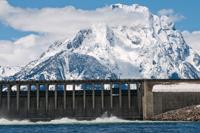The Bureau of Reclamation’s annual fall tapering of water releases from Jackson Lake Dam began Monday and will continue through the middle of next week.
Discharge from the dam into the Snake River was around 1,800 cubic feet per second this past weekend, but it fell to 1,550 cfs by the end of Monday. The schedule calls for another drop to 1,300 Tuesday, 1,100 by Wednesday, 900 by Thursday and 750 by Friday. Flows will hover at that level for the weekend before dropping to 600 cfs on Oct. 1, 450 on Oct. 2 and to the final winter flow rate of around 350 to 450 cfs come Oct. 3.
Although the Snake will pick up another 350 cfs or so after the Buffalo Fork and Pacific Creek confluences, the result will be decidedly slower floats in Grand Teton National Park and further downstream.
Jackson Lake, currently 78 percent full, is about as flush as it can be per the terms of a flood control agreement with the U.S. Army Corps of Engineers.
“It was a good water year, and we try to keep the water as high in the system as we can,” said Brian Stevens, the bureau’s Upper Snake Field Office water operations manager.
Before entering Palisades Reservoir, the Snake is carrying around 3,850 cfs. Short of a big rain event, Snake River Canyon flows stand to drop to 2,500 cfs by the middle of next week. Palisades on Monday was 55 percent full and discharging 7,000 cfs, which is significantly more water than it was receiving from the Snake, Greys and Salt river inflows.
